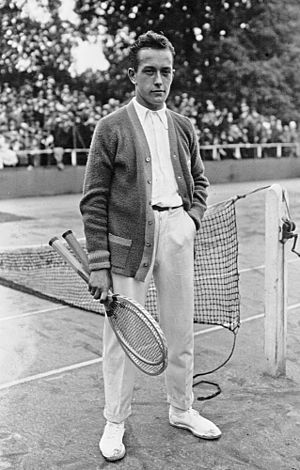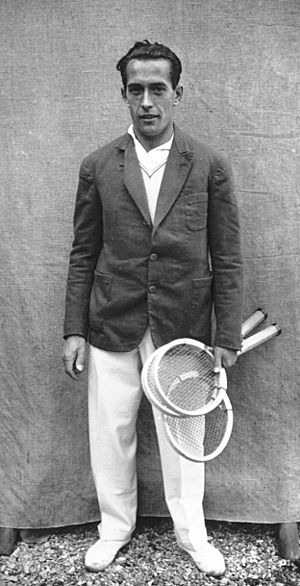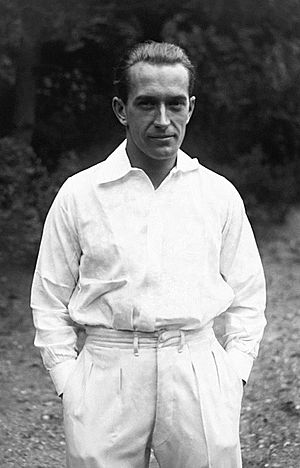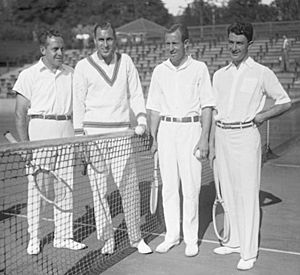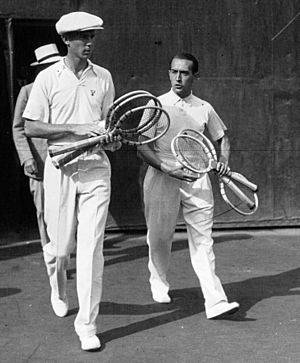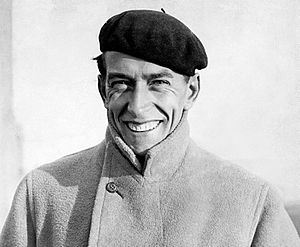Henri Cochet facts for kids
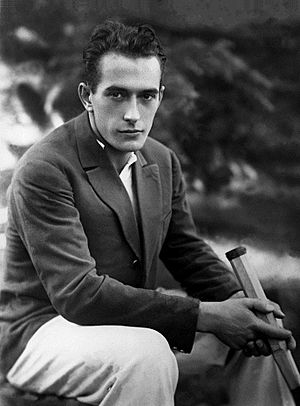
Cochet at the 1924 Olympics
|
|||||||||||
| Full name | Henri Jean Cochet | ||||||||||
|---|---|---|---|---|---|---|---|---|---|---|---|
| Country (sports) | |||||||||||
| Born | 14 December 1901 Villeurbanne, France |
||||||||||
| Died | 1 April 1987 (aged 85) Saint-Germain-en-Laye, France |
||||||||||
| Height | 1.68 m (5 ft 6 in) | ||||||||||
| Turned pro | 1933 (amateur tour from 1920) | ||||||||||
| Retired | 1958 (as a reinstated amateur) | ||||||||||
| Plays | Right-handed (one-handed backhand) | ||||||||||
| Int. Tennis HoF | 1976 (member page) | ||||||||||
| Singles | |||||||||||
| Career record | 684–186 (78.6%) | ||||||||||
| Career titles | 90 | ||||||||||
| Highest ranking | No. 1 (1928, A. Wallis Myers) | ||||||||||
| Grand Slam singles results | |||||||||||
| French Open | W (1926, 1928, 1930, 1932) | ||||||||||
| Wimbledon | W (1927, 1929) | ||||||||||
| US Open | W (1928) | ||||||||||
| Other tournaments | |||||||||||
| WHCC | W (1922) | ||||||||||
| WCCC | W (1922, 1923) | ||||||||||
| Professional majors | |||||||||||
| Wembley Pro | SF (1937) | ||||||||||
| French Pro | W (1936) | ||||||||||
| Doubles | |||||||||||
| Grand Slam doubles results | |||||||||||
| French Open | W (1927, 1930, 1932) | ||||||||||
| Wimbledon | W (1926, 1928) | ||||||||||
| Other doubles tournaments | |||||||||||
| WHCC | W (1922) | ||||||||||
| WCCC | W (1922, 1923) | ||||||||||
| Mixed doubles | |||||||||||
| Grand Slam mixed doubles results | |||||||||||
| French Open | W (1928, 1929) | ||||||||||
| Wimbledon | SF (1930, 1932) | ||||||||||
| US Open | W (1927) | ||||||||||
| Other mixed doubles tournaments | |||||||||||
| WHCC | W (1922, 1923) | ||||||||||
| Team competitions | |||||||||||
| Davis Cup | W (1927, 1928, 1929, 1930, 1931, 1932) | ||||||||||
|
Medal record
|
|||||||||||
Henri Jean Cochet (born December 14, 1901 – died April 1, 1987) was a famous French tennis player. He was known as a world No. 1 player. Henri was also a key member of the "Four Musketeers" from France. This group of players was super strong in tennis during the late 1920s and early 1930s.
Henri Cochet was born in Villeurbanne, France. He won a total of 22 major tennis titles. These included seven Grand Slam singles titles, five doubles titles, and three mixed doubles titles. He also won other important tournaments. He was ranked as the world No. 1 player for four years in a row, from 1928 to 1931. Cochet became a professional player in 1933. After World War II, he became an amateur player again in 1945.
In 1976, Henri Cochet and the other "Four Musketeers" were all added to the International Tennis Hall of Fame. Cochet passed away in 1987 in Paris when he was 85 years old.
Contents
- Early Life and How He Started Tennis
- Henri Cochet's Tennis Career
- Personal Life
- Grand Slam Finals
- Other Major Tournament Wins
- Images for kids
- See also
Early Life and How He Started Tennis
Henri Cochet was born on December 14, 1901. His father worked as a groundskeeper at a tennis club in Lyon. This meant Henri could practice tennis for free. He started playing when he was eight years old, along with his sister. The club president, Georges Cozon, saw how talented Henri was. He offered to coach him.
In 1920, Henri played in his first local tournament. He even played against his coach in the final! In 1921, he decided to play in Paris, which was the center of French tennis. He won a tournament there, beating Jean Borotra. This helped him become one of the top ten French players that year. His sister, Aimée, also became a tennis player.
Henri Cochet's Tennis Career
Becoming a Top Player (1922–1925)
In 1922, Cochet traveled to Switzerland for the World Covered Court Championships. He won the singles title there, again beating Jean Borotra. He also won the doubles title with Borotra. Later that year, he won the World Hard Court Championships in Belgium. He won both singles and doubles events. After these big wins, Cochet became the top-ranked player in France. He also joined the France Davis Cup team for the first time.
In 1923, Cochet won the World Covered Court Championships again. In 1924, he won two silver medals at the 1924 Summer Olympics in Paris. He won silver in singles and in doubles with Borotra. At the end of 1924, he was ranked among the top players in France and the world. He missed most of the 1925 season due to business and injuries.
The Famous "Musketeers Era" (1926–1933)
First Big International Wins (1926–1927)
In 1926, Cochet won the French Championships. He beat René Lacoste to become the champion. A month later, he won his first 1926 Wimbledon Championships doubles title with Jacques Brugnon. In September, the French players, including Cochet, played in the U.S. National Championships. Cochet beat Bill Tilden, who was a huge American star. This ended Tilden's six-year winning streak. Cochet was ranked among the top three players in the world in 1926.
In 1927, Cochet continued to win many tournaments. He won the doubles title at the French Championships with Jacques Brugnon. Then came the 1927 Wimbledon Championships. Cochet had an amazing comeback in the semi-finals against Bill Tilden. He was two sets down and Tilden had a match point, but Cochet fought back to win! In the final, he beat Jean Borotra in another five-set match. This was a record comeback at Wimbledon.
Later in 1927, the French "Musketeers" faced the American team in the Davis Cup final. France won 3–2, with Cochet winning the final match. This was the first time France won the Davis Cup since 1920. Cochet also won the mixed doubles at the U.S. National Championships.
Becoming World Number One (1928)
The year 1928 was when Cochet became the world's top player. He won many tournaments in France. He won his second French International Championships title, beating René Lacoste. He also won the mixed doubles title there. At 1928 Wimbledon Championships, he reached the final but lost to Lacoste. However, he and Brugnon won the doubles title again.
In July, the "Musketeers" won the Davis Cup again, beating the United States. Cochet won all three of his matches. Then, he won the U.S. National Championships in a tough five-set final. By the end of 1928, Henri Cochet was officially ranked as the World No. 1 amateur tennis player.
Continuing French Success (1929)
In 1929, Cochet continued his winning ways. He won the Monte Carlo Cup for the second time. He also won the Austrian and Czechoslovakian Championships. At the French Championships, he won the mixed doubles title.
Rivalry with the United States Team
Cochet was the top player at the 1929 Wimbledon Championships. He won the singles title, beating Bill Tilden in the semi-finals and Jean Borotra in the final. This was the sixth time in a row a French player won Wimbledon.
In July, the French team faced the United States again in the Davis Cup final. Cochet played a fantastic match against Bill Tilden, winning easily. Even though the American team won the doubles, Cochet won his final match against George Lott. This secured the Davis Cup for France for the third time! Cochet was ranked World No. 1 again in 1929.
The Musketeers Continue (1930)
In 1930, Cochet focused more on doubles early in the year. His best performance was at the French Championships. He won the singles title, beating Bill Tilden. He also won the doubles title with Jacques Brugnon. He reached the mixed doubles final too.
The French team won the Davis Cup final for the fourth time in a row. Cochet won his singles match and helped win the doubles with Brugnon. He was ranked World No. 1 again at the end of 1930.
Dealing with Health Issues (1931)
In 1931, Cochet won the Monaco Cup for the third time. He also became the Danish Covered Courts champion. He won the Austrian International Championships too. However, he started having a shoulder injury. He also missed the French Championships due to a fever.
At 1931 Wimbledon Championships, Cochet surprisingly lost in the very first round. Despite these challenges, the "Four Musketeers" were ready for the Davis Cup final against Great Britain. Cochet won his singles matches and the doubles with Brugnon. This helped France win its fifth straight Davis Cup! Even with a tough year, Cochet was still ranked number one by many experts.
New Rivals and Turning Professional (1932-1933)
In 1932, Cochet won his fifth and last French Championships singles title. He also won his third French doubles title with Jacques Brugnon. He now held a record ten French titles, which is the most for a male player.
At 1932 Wimbledon Championships, he lost early. The American player Ellsworth Vines won the singles title. The American Davis Cup team challenged France again. The French Musketeers won the cup for the sixth and final time. Cochet and Vines played a match where Vines won. Later, Vines also beat Cochet in the U.S. National Championships final. These losses meant Vines took over the World No. 1 ranking from Cochet.
In 1933, Cochet lost his French Championships title to Jack Crawford from Australia. The French team also lost the Davis Cup for the first time since 1927. These events marked the end of the "Four Musketeers" era of dominance.
Professional Tennis Career (1933–1939)
On September 9, 1933, Henri Cochet became a professional tennis player. This meant he could earn money from playing. He joined a tour with other famous players like Bill Tilden. He played many exhibition matches and tournaments across the world.
In 1936, Cochet won his first major professional title, the French Pro Championship. He also played in the International Pro Championship of Britain, where he reached the final. He even traveled to the Soviet Union to put on tennis shows. In 1937, he reached the semi-finals of the Wembley Pro tournament. He continued to tour and play matches until World War II began.
During World War II (1939–1945)
During World War II, France was taken over by Nazi Germany. For a short time, Cochet was held as a prisoner. After he was released, he could not leave France. He opened his own sports store in Paris. He also worked with the French government to organize sports programs. In 1941, he was allowed to become an amateur tennis player again. He played in some French tournaments during the war, winning doubles titles.
Later Amateur Years (1945–1958)
After World War II ended, Cochet continued to play as an amateur. He won the Dutch championships in 1947. He also played in many tournaments in Europe. He often played against and coached younger players like Yvon Petra.
Henri Cochet played one of his last matches in 1958 in Switzerland. He was 56 years old but still managed to win a doubles match. He retired from tennis later that year.
Personal Life
Henri Cochet married Germaine Desthieux in 1926. He taught her how to play tennis, and they sometimes played in tournaments together. Besides tennis, Cochet also played amateur ice hockey. He owned a sports store in Paris. He also coached young French tennis players for free. In 1951, he received the Red Ribbon of the Legion of Honour, a special award for his achievements in sports. He passed away in 1987 at the age of 85.
Grand Slam Finals
Henri Cochet played in many Grand Slam finals. Here are his results:
Singles: 10 Finals (7 Wins, 3 Losses)
- 1926 French Championships: Won against René Lacoste (France)
- 1927 Wimbledon: Won against Jean Borotra (France)
- 1928 French Championships: Won against René Lacoste (France)
- 1928 Wimbledon: Lost to René Lacoste (France)
- 1928 U.S. National Championships: Won against Frank Hunter (USA)
- 1929 Wimbledon: Won against Jean Borotra (France)
- 1930 French Championships: Won against Bill Tilden (USA)
- 1932 French Championships: Won against Giorgio de Stefani (Italy)
- 1932 U.S. National Championships: Lost to Ellsworth Vines (USA)
- 1933 French Championships: Lost to Jack Crawford (Australia)
Doubles: 11 Finals (5 Wins, 6 Losses)
- 1926 Wimbledon: Won with Jacques Brugnon (France)
- 1927 French Championships: Won with Jacques Brugnon (France)
- 1928 Wimbledon: Won with Jacques Brugnon (France)
- 1930 French Championships: Won with Jacques Brugnon (France)
- 1932 French Championships: Won with Jacques Brugnon (France)
Mixed Doubles: 5 Finals (3 Wins, 2 Losses)
- 1927 U.S. National Championships: Won with Eileen Bennett (Great Britain)
- 1928 French Championships: Won with Eileen Bennett (Great Britain)
- 1929 French Championships: Won with Eileen Bennett (Great Britain)
Other Major Tournament Wins
Henri Cochet also won several other important international tournaments:
- World Hard Court Championships: Singles (1922), Doubles (1922), Mixed Doubles (1922, 1923)
- World Covered Court Championships: Singles (1922, 1923), Doubles (1922, 1923)
- French Pro Championship: Singles (1936)
Images for kids
See also
 In Spanish: Henri Cochet para niños
In Spanish: Henri Cochet para niños


